2017 Ducati Monster 1200S First Ride Review
Ducatis big naked gets upgraded
The principality of Monaco is an imbecilic location for a motorcycle ride. After all, the independent microstate on the French Riviera isn’t even twice as big as the Dodger Stadium grounds, and its teeny little streets are crammed almost solid with a cornucopia of vehicles from two-stroke scooters to the apparently riotously amusing Renault Twizys to exotic McLarens to horrifyingly huge Rollers.
2017 Ducati Monster 1200
| Engine | 19.25/20 |
| Suspension/Handling | 14.0/15 |
| Transmission/Clutch | 8.5/10 |
| Brakes | 9.75/10 |
| Instruments/Controls | 4.75/5 |
| Ergonomics/Comfort | 9.0/10 |
| Appearance/Quality | 9.0/10 |
| Desirability | 8.25/10 |
| Value | 7.5/10 |
| Overall Score | 90/100 |
2017 Ducati Monster 1200 Preview
Then again, if the stats are true and 30% of its population are millionaires, I suppose many people in this odd little place wouldn’t be frightened by paying around $15,000 for an expensive Italian toy like Ducati’s freshly revamped Monster 1200. Enticed by power and style and the magical mountain roads just a few miles away from the coast, an intrepid Monacoian might think the biggest Monster would make a perfect fit parked in the garage next to a Ferrari.
Ducati’s iconic Monster line, which launched in 1993 and went on to earn lucrative profits for the financially flimsy Italian company at the time, finds itself in a dichotomous spot during its successful modern era. At its bottom end is the new 797 Monster, which harkens back to the original air-cooled Monsters with a punch rated at a modest 75 horsepower. At the upper end are the liquid-cooled 1200 Monsters, which are the most powerful unfaired sportbikes Ducati produces.
2014 Ducati Monster 1200 S First Ride Review
The 1200 debuted in 2014, and it’s being upgraded just three years later with tweaked styling that better mimics the original. A reshaped fuel tank and slimmer tailsection deliver an attractive makeover, and a bright new headlight leads the way. Oh, and the Monster 12 makes a more compelling proposition when some extra power, greater agility, and Bosch’s excellent Cornering ABS is tossed into the mix for 2017.
The cockpit is familiar but updated with the addition of a prominent gear-position indicator and fuel gauge added to its vivid color TFT gauge pack, strange omissions in the previous version. As before, a tapered aluminum handlebar places a rider in a slightly forward lean for a sporty stance and strong leverage. The seat is adjustable for height (31.3 to 32.3 inches) and is nicely supportive. Quality hand levers are adjustable over a wide sweep.
The last Monster 1200 had many admirable qualities, but it was cursed with footpegs that didn’t provide enough room for a rider to place feet in a proper sporting position near the toes. It was an infuriating critique for a Ducati, considering the brand’s rich sporting heritage. Hitting the recycle bin are the former aluminum castings that joined passenger and pilot pegs in one piece, now replaced by separate peg mounts and alleviating our biggest gripe with the previous big Monster. Whiney size 13ers may still wish for more room when sport riding, but there is now a Bentley’s worth of extra space for the heels of men packing significant feet.
There are a couple of ergonomic quibbles for legs. The rubber-covered footpegs can be a mite slippery when wet, and the footpegs are mounted high enough to avoid any ground clearance issues, but their location also forces a tighter knee bend than something like KTM’s expansive Super Duke.
The previous 1200 Monsters were given different power outputs, with the S model rewarded with 10 bonus ponies at 145 horsepower. Now, with new cylinder heads and ECU tuning, both are claimed to deliver 150 metric hp (148 hp in our imperial measure) while meeting Euro 4 regs. We’ll expect about 136 horses at the rear wheel based on our dyno testing of the 2016 Monster in this shootout.
The motor is amazingly friendly for a mill that punches so hard at wide-open throttle, responding cleanly even from below 3000 rpm and building through a thrusting midrange to an I-dare-ya peak at 9250 rpm. Helping make the most of its power is Ducati’s quickshifter system that allows full-throttle upshifts. The S model also allows clutchless downshifts by automatically blipping the throttle to match engine revs with wheel speeds, a system optional on the base model
The S also distinguishes itself with Öhlins suspension that worked flawlessly on the mountain roads in and around Monaco where we sampled the bike. The S also receives Brembo’s superlative M50 brake calipers instead of the merely excellent M432s, as well as 330mm rotors instead of 320s. Additionally, the S uses a different set of wheels with red markings, although they aren’t of the lighter-weight forged variety. You’ll have to upgrade to the 160-hp Monster 1200R for that, which ramps up the MSRP past the $19k mark.
The steep mountain roads in southern France gave the Monster’s electronics suite a thorough workout over switchbacks and shady sections at altitude that were wet and potentially icy. I began the ride in Touring mode, which delivers a friendly array of settings for throttle response, traction control, ABS and wheelie control. Stepping up to Sport mode backs down the intervention and allows behavior more appropriate of the bike’s name. Ducati deserves kudos for allowing customization of each parameter independent of ride modes. As such, a rider can exactly dial in the control desired. For me in Sport mode, I reduced TC from 3 to 2 and switched off wheelie control to attain personal electronic bliss.
New for 2017 is the addition of Cornering ABS to the Bosch electronics suite, which uses an Intertial Measurement Unit (IMU) to monitor multiple axes of movement. The mountain roads we sampled were often wet in shady areas, and it was comforting to have the security of knowing we could use the brakes aggressively in corners if conditions required it, as the system can briefly release brake pressure if traction is reduced while leaned over in corners. ABS is customizable to three settings, including one that switches off rear ABS for hooligan-style corner entries if desired.
Motoring machines, even pricey ones, are never flawless, but my day aboard the Monster 1200S gave me so little negative to consider. Power output is way beyond adequate, brakes and electronics are as good as they get, and it now cuts a more dashing profile.
However, here in Monaco, I imagined I’d identify myself as a plebe if I didn’t whinge a little. I mean, surely Prince Albert would bitch if his Bugatti Chiron didn’t shift as smoothly as his Pagani Huayra.
Similarly, Monster’s gearbox could use a dose of slickness. It’s not that it swaps cogs harshly, it’s just that it requires more effort than the trannies in most modern motorbikes. I’ll also note the quickshift system borrowed from the Panigale doesn’t always deliver shifts as smooth as from an expert clutch hand, depending on the thousands of different parameters experienced during the variety of street speeds and environments. Not at all bad; just not perfect. It functions best at full rip, preferably on a racetrack.
There, now get your sandy feet off my yacht! I’m sailing over to my Ducati dealer to negotiate a set of forged Marchesinis for my Monster.
2017 Ducati Monster 1200
+ Highs
- Italian style, now old and improved
- Top-shelf electronics
- Big V-Twin power and sound
– Sighs
- Ain’t cheap unless you’re in Monaco
- Unsightly radiator hoses clash with tuxedos
- Ultra-competitive market for naked sportbikes
2017 Ducati Monster 1200 Specifications | 2017 Ducati Monster 1200 S Specifications | |
|---|---|---|
| MSRP | $14,695 | $17,195 ($16,995 in red) |
| Engine | Testastretta 11°, L-Twin cylinder, 4 Desmodromically actuated valves per cylinder, Dual spark, Liquid cooled | |
| Displacement | 1198 cc | |
| Bore X stroke | 106 x 67.9 mm | |
| Compression ratio | 13,0:1 | |
| Power | 148 at 9.250 rpm (claimed) | |
| Torque | 93.1 lb-ft at 7,750 rpm (claimed) | |
| Fuel injection | Electronic fuel injection system, full Ride-by-Wire system, equivalent diameter 56 oval throttle bodies | |
| Exhaust | Lightweight 2-1-2 system with catalytic converter and 2 lambda probes, twin stainless steel mufflers with aluminium covers and end caps | |
| Transmission | 6-speed gearbox | |
| Primary drive | Straight cut gears; Ratio 1.84:1 | |
| Final drive | Chain; Front sprocket Z15; Rear sprocket Z41 | |
| Clutch | Slipper and self-servo wet multiplate clutch with hydraulic control | |
| Frame | Tubular steel Trellis frame attached to the cylinder heads | |
| Front suspension | 43 mm Kayaba fully adjustable USD fork | 48 mm Öhlins fully adjustable usd fork |
| Front wheel | 10-spoke light alloy, 3.50″ x 17″ | Y shaped 3-spoke light alloy with “S” graphics, 3.50” x 17” |
| Front tire | Pirelli Diablo Rosso III 120/70 ZR17 | |
| Rear suspension | Progressive linkage with Sachs fully adjustable monoshock, aluminium single-sided swingarm | Progressive linkage with Öhlins fully adjustable monoshock, Aluminium single-sided swingarm |
| Rear wheel | 10-spoke light alloy, 6.00″ x 17″ | Y shaped 3-spoke light alloy with “S” graphics, 6.00” x 17” |
| Rear tire | Pirelli Diablo Rosso III 190/55 ZR17 | |
| Wheel travel (front/rear) | 5.12 in. / 5.87 in. | |
| Front brake | 2 x 320 mm semi-floating discs, radially mounted Brembo Monobloc M4.32 callipers, 4-piston, radial pump with Bosch cornering ABS as standard equipment | 2 x 330 mm semi-floating discs, radially mounted Brembo Monobloc M50 calipers, 4-piston, radial pump with Bosch cornering ABS as standard equipment |
| Rear brake | 245 mm disc, 2-piston calliper, with Bosch cornering ABS as standard equipment | |
| Instrumentation | Full-TFT colour display | |
| Wet weight | 470 lb. (claimed) | 465 lb. (claimed) |
| Seat height | Adjustable 31.30 – 32.28 in. | |
| Wheelbase | 58.46 in. | |
| Rake | 23.3° | |
| Front wheel trail | 3.41 in. | |
| Fuel tank capacity | 4.36 gallons | |
| Number of seats | Dual seat | |
| Standard Equipment | Riding Modes, Power Modes, Ducati Safety Pack (Bosch cornering ABS + DTC + DWC), RbW, Passenger seat cover, Anti-theft system ready, DMS ready, DDA, LED position light and tail light, USB power socket. | Adds Ducati Quick Shift (DQS) up/down and Carbon fiber front mudguardt |
| Warranty | 24 months unlimited mileage | |
| Maintenance | 9,000 mi / 12 months | |
| Valve clearance adjustment | 18,000 mi | |
| Emission standard | Euro 4 | |
| ECO2 emissions | 122 g/km | |
| Fuel consumption | 45.2 mpg (claimed) | |
More by Kevin Duke



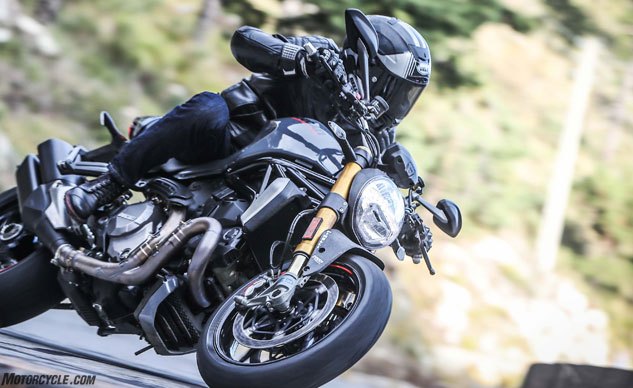


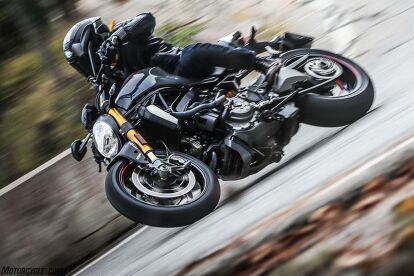


















































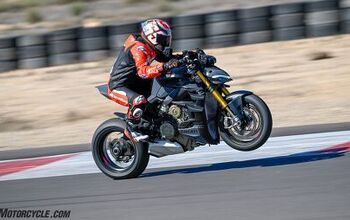
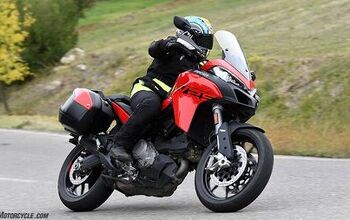
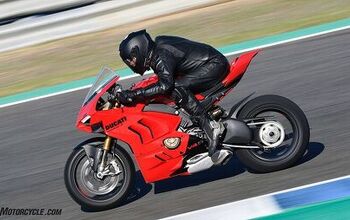














Comments
Join the conversation
Mostly gorgeous, but they need to hire someone from Harley or Triumph to learn them how to hide the hoses.
And bring back the yellow! Why paint such a spunky bike such a drab color?
Anyway, nice article. I'm sure that was a tough assignment.
I understand why Ducati sets up a 2017 Monster 1200 S press test ride in Monte Carlo. It's a premium bike in a very premium town. It affects the senses. But this piece just seems to continue a trend where journos get what experiences they get with new bikes, in that those moments are mainly with the higher specced stuff, and hey, I'd take it too, but the story of generally flawless Ohlins is a tired one. Yes, they make great suspension. I have yet to hear or read a review of a bike outfitted with Ohlins that the rider, whatever their experience, thinks "eh, pass." I, meanwhile, am eternally curious about whether current standard specced bikes or those coming down the pike are in fact making inroads insofar as real-world suspension performance. My presumption is that, for the ignorant, it doesn't much matter. In other words, all good y'all, the 2017 Monster 1200 (no S): just peachy. More than enough. I've heard seemingly countless reports of ownership of Ohlins-equipped machines, or Ohlins' equivalents, and they often follow a continuum. "I couldn't resist. They just looked so cool. Full adjustability, fully serviceable." Etc. Later on it's "Frankly, it's like anything, set it and forget it. It's great for racing or serious track day use, but otherwise it's just a luxury." So for what financial burden of the overall cost of a bike Ohlins adds, is it sensible to give it so much focus? I don't address this just to the moto press. I question Ducati as well. Is Ducati essentially preempting their own product by saying, "We've got a great bike, new bike, aaaand what we really advise is you get the one with the suspension NOT built by us."?